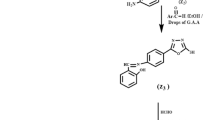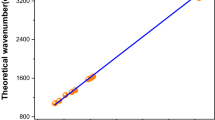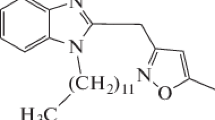Abstract
The optimal inhibition efficiency of DBTA (4-Dimethylamino-benzylidene)-[1, 3, 4]thiadiazol-2-yl-amine) for MS (mild steel) in 1.0 M hydrochloric acid solution was achieved through employing electrochemical impedance spectroscopy (EIS) and weight loss techniques in addition to Scanning Electron Microscopy (SEM). Theoretical calculations based on Density functional theory (DFT) method were carried out for DBTA. Investigations of the mechanism for the corrosion inhibition for MS with DBTA in acidic solution by molecular simulations were performed. The results demonstrated that DBTA is an excellent corrosion inhibitor for MS in corrosive solution, and the inhibitory effectiveness was 91%, much higher than that expected at the highest concentration of DBTA. Spontaneous process of adsorption of DBTA on the mild steel surface was proved based on Langmuir adsorption isotherm.










Similar content being viewed by others
References
Bentiss F, Lebrini M, Traisnel M, Lagrenée M (2009) Synergistic effect of iodide ions on inhibitive performance of 2,5-bis(4-methoxyphenyl)-1,3,4-thiadiazole during corrosion of mild steel in 0.5 M sulfuric acid solution. J Appl Electrochem 39:1399–1407
Kumar S, Sharma D, Yadav P, Yadav M (2013) Experimental and quantum chemical studies on corrosion inhibition effect of synthesized organic compounds on N80 steel in hydrochloric acid. Ind Eng Chem Res 52:14019–14029
Al-Baghdadi1, S. B.; Noori, F. T. M.; Ahmed, W. K.; Al-Amiery. A. A. Thiadiazole as a Potential Corrosion Inhibitor for Mild Steel in 1 M HCl. J. Adv. Electrochem. 2016, 2, 67-69
Bentiss F, Traisnel M, Vezin H, Hildebrand HF, Lagrenée M (2004) 2,5-Bis(4-dimethylaminophenyl)-1,3,4-oxadiazole and 2,5-bis(4-dimethylaminophenyl)-1,3,4-thiadiazole as corrosion inhibitors for mild steel in acidic media. Corros Sci 46:2781–2792
Yadav M, Kumar S, Behera D (2013) Inhibition effect of substituted thiadiazoles on corrosion activity of N80 steel in HCl solution. J Metall 2013:1–14
Al-Baghdadi SB, Hashim FG, Salam AQ, Abed TK, Gaaz TS, Al-Amiery AA, Kadhum AH, Reda KS, Ahmed WK (2018) Synthesis and corrosion inhibition application of NATN on mild steel surface in acidic media complemented with DFT studies. Results Phys 8:1178–1184
Habeeb HJ, Luaibi HM, Dakhil RM, Kadhum AH, Al-Amiery AA, Gaaz TS (2018) Development of new corrosion inhibitor tested on mild steel supported by electrochemical study. Results Phys 8:1260–1267
Singh P, Singh A, Quraishi MA (2014) Inhibition effect of 1,3,5-tri-p-tolyl-1,3,5-triazene on the corrosion of brass in 0.5 M HCl solution. Res Chem Intermed 40:595–604
Sulaiman KO, Onawole AT (2016) Quantum chemical evaluation of the corrosion inhibition of novel aromatic hydrazide derivatives on mild steel in hydrochloric acid. Comput Theor Chem 1093:73–80
Turcio-Ortega D, Pandiyan T, Cruz J, Garcia-Ochoa E (2007) Interaction of imidazoline compounds with fen (n = 1-4 Atoms) as a model for corrosion inhibition: DFT and electrochemical studies. J Phys Chem C 111:9853–9866
Standard A. G1–03. Standard Practice for preparing, cleaning, and evaluating corrosion test specimens. Annual Book ASTM Standards 2003, 3, 17-25
Deng Q, Shi H-W, Ding N-N, Chen B-Q, He X-P, Liu G, Tang Y, Long Y-T, Chen G-R (2012) Novel triazolyl bisamino acid derivatives readily synthesized via click chemistry as potential corrosion inhibitors for mild steel in HCl. Corros Sci 57:220–227
Tao Z, He W, Wang S, Zhang S, Zhou G (2012) A study of differential polarization curves and thermodynamic properties for mild steel in acidic solution with nitrophenyltriazole derivative. Corros Sci 60:205–213
Becke AD (1993) Density-functional thermochemistry. III. The role of exact exchange. J Chem Phys 98:5648–5652
Becke AD (1988) Density-functional exchange-energy approximation with correct asymptotic behaviour. Phys Rev A 38:3098–3100
Haque J, Verma C, Srivastava V, Quraishi MA, Ebenso EE (2018) Experimental and quantum chemical studies of functionalized tetrahydropyridines as corrosion inhibitors for mild steel in 1 M hydrochloric acid. Results Phys 9:1481–1493
Verma C, Olasunkanmia LO, Ebensoa EE, Quraishi MA (2018) Substituents effect on corrosion inhibition performance of organic compounds in aggressive ionic solutions: a review. J Mol Liq 251:100–118
Khaled KF, Al-Qahtani MM (2009) The inhibitive effect of some tetrazole derivatives towards Al corrosion in acid solutions: chemical electrochemical and theoretical studies. Mater Chem Phys 113:150–158
Musa AY, Mohamad AB, Kadhum AAH, Takriff MS (2012) Corrosion inhibition of mild steel in 1.0 M HCl by aminocompound: electrochemical and DFT studies. Metall Mater Trans A 43:3379–3386
Noor EA (2009) Evaluation of inhibitive action of some quaternary N-heterocyclic compounds on the corrosion of Al–Cu alloy in hydrochloric acid. Mater Chem Phys 114:533–541
Kadhum A, Al-Amiery A (2014) Inhibition of mild steel corrosion in hydrochloric acid solution by new coumarin. Materials 7:4335–4348
Bosch RW et al (2001) Electrochemical frequency modulation: a new electrochemical technique for online corrosion monitoring. Corrosion 57:60–70
Ramesh V, Adhikari AV (2008) Quinolin-5-ylmethylene-3-{[8-(trifluoromethyl)quinolin-4-yl]thio}propanohydrazide as an effective inhibitor of mild steel corrosion in HCl solution. Corros Sci 50:55–61
Singh P, Ebenso EE, Olasunkanmi LO, Obot IB, Quraishi MA (2016) Electrochemical, theoretical, and surface morphological studies of corrosion inhibition effect of green naphthyridine derivatives on mild steel in hydrochloric acid. J Phys Chem C 120:3408–3419
Mishra A, Verma C, Lgaz H, Srivastava V, Quraishi MA, Ebenso EE (2018) Synthesis, characterization and corrosion inhibition studies of N-phenyl-benzamides on the acidic corrosion of mild steel: experimental and computational studies. J Mol Liq 251:317–332
Verma C, Olasunkanmi LO, Ebenso EE, Quraishi MA, Obot IB (2016) Adsorption behavior of glucosamine-based, pyrimidine-fused heterocycles as green corrosion inhibitors for mild steel: experimental and theoretical studies. J Phys Chem C 120:11598–11611
Singh P, Quraishi MA (2016) Corrosion inhibition of mild steel using Novel Bis Schiff’s Bases as corrosion inhibitors: electrochemical and surface measurement. Measurement 86:114–124
Singh P, Singh A, Quraishi MA (2016) Thiopyrimidine derivatives as new and effective corrosion inhibitors for mild steel in hydrochloric acid: electrochemical and quantum chemical studies. J Taiwan Inst Chem Eng 60:588–601
Mendonça GLF, Costa SN, Freire VN, Casciano PNS, Correia AN, de Lima-Neto P (2017) Understanding the corrosion inhibition of carbon steel and copper in sulphuric acid medium by amino acids using electrochemical techniques allied to molecular modelling methods. Corros Sci 115:41–55
Ansari KR, Quraishi MA (2015) Experimental and computational studies of naphthyridine derivatives as corrosion inhibitor for N80 steel in 15% hydrochloric acid. Phys E 69:322–331
Singh P, Makowska-Janusik M, Slovensky P, Quraishi MA (2016) Nicotinonitriles as green corrosion inhibitors for mild steel in hydrochloric acid: electrochemical, computational and surface morphological studies. J Mol Liq 220:71–81
Obot IB, Gasem ZM (2014) Theoretical evaluation of corrosion inhibition performance of some pyrazine derivatives. Corros Sci 83:359–366
Guo L, Ren X, Zhou Y, Xu S, Gong Y, Zhang S (2017) Theoretical evaluation of the corrosion inhibition performance of 1,3-thiazole and its amino derivatives. Arab J Chem 10:121–130
Abd El-Lateef HM (2015) Experimental and computational investigation on the corrosion inhibition characteristics of mild steel by some novel synthesized imines in hydrochloric acid solutions. Corros Sci 92:104–117
Abd El-Lateef HM, Abu-Dief AM, Abdel-Rahman LH, Sanudo EC, Aliaga-Alcalde N (2015) Electrochemical and theoretical quantum approaches on the inhibition of C1018 carbon steel corrosion in acidic medium containing chloride using some newly synthesized phenolic Schiff bases compounds. J Electroanal Chem 743:120–133
Olasunkanmi LO, Obot IB, Ebenso EE (2016) Adsorption and corrosion inhibition properties of N-{n-[1-R-5-(quinoxalin-6-yl)-4,5-dihydropyrazol- 3 yl] phenyl} methane sulfon amides on mild steel in 1 M HCl: experimental and theoretical studies. RSC Adv 6:86782–86797
Gómez-Zavaglia A, Reva ID, Frija L, Cristiano ML, Fausto R (2005) Molecular structure, vibrational spectra and photochemistry of 2-methyl-2H-tetrazol-5-amine in solid argon. J Phys Chem A 109(35):7967–7976
Ramya K, Mohan R, Anupama KK, Joseph A (2015) Electrochemical and theoretical studies on the synergistic interaction and corrosion inhibition of alkyl benzimidazoles and thiosemicarbazide pair on mild steel in hydrochloric acid. Mater Chem Phys 149:632–647
Cruz J, Pandiyan T, Garcıa-Ochoa E (2005) A new inhibitor for mild carbon steel, electrochemical and DFT studies. J Electroanal Chem 583:8–16
Costa JM, LIuch jm (1984) The use of quantum mechanics calculations for the study of corrosion inhibitors. Corros Sci 24:924–933
Khalil N (2003) Quantum chemical approach of corrosion inhibition. Electrochim Acta 48:2635–2640
Al-Amiery AA (2012) Antimicrobial and antioxidant activities of new metal complexes derived from (E)-3-((5-phenyl-1,3,4-oxadiazol-2-ylimino) methyl)naphthalen-2-ol. Med Chem Res 21:3204–3213
Xia S, Qiu M, Yu L, Liu F, Zhao H (2008) Molecular dynamics and density functional theory study on relationship between structure of imidazoline derivatives and inhibition performance. Corros Sci 50:2021–2029
Musa AY, Kadhum AH, Mohamad AB, Rahoma AB, Mesmari H (2010) Electrochemical and quantum chemical calculations on 4,4-dimethyloxazolidine-2-thione as inhibitor for mild steel corrosion in hydrochloric acid. J Mol Struct 969:233–327
Lee C, Yang W, Parr RG (1988) Development of the colle-salvetti correlation-energy formula into a functional of the electron density. Phys Rev B 37:785–789
Frisch MJ (2007) Gaussian 03, revision E.01. Gaussian Inc., Wallingford
Martinez S (2003) Inhibitory mechanism of mimosa tannin using molecular modeling and substitutional adsorption isotherms. Mater Chem Phys 77:97–102
Olasunkanmi LO, Obot IB, Kabanda MM, Ebenso EE (2015) Some quinoxalin-6-yl derivatives as corrosion inhibitors for mild steel in hydrochloric acid: experimental and theoretical studies. J Phys Chem C 119:16004–16019
Pearson RG (1988) Absolute electronegativity and hardness: application to inorganic chemistry. Inorg Chem 27:734–740
Acknowledgements
The authors gratefully acknowledge the support provided by the UKM-YSD Chair on Sustainable Development for the Grant 020–2017’Malaysia’ to carry out this research.
Author information
Authors and Affiliations
Corresponding author
Ethics declarations
Conflict of interest
The authors declare that they have no conflict of interest.
Additional information
Publisher's Note
Springer Nature remains neutral with regard to jurisdictional claims in published maps and institutional affiliations.
Rights and permissions
About this article
Cite this article
Salman, T.A., Zinad, D.S., Jaber, S.H. et al. Effect of 1,3,4-Thiadiazole Scaffold on the Corrosion Inhibition of Mild Steel in Acidic Medium: An Experimental and Computational Study. J Bio Tribo Corros 5, 48 (2019). https://doi.org/10.1007/s40735-019-0243-7
Received:
Revised:
Accepted:
Published:
DOI: https://doi.org/10.1007/s40735-019-0243-7




